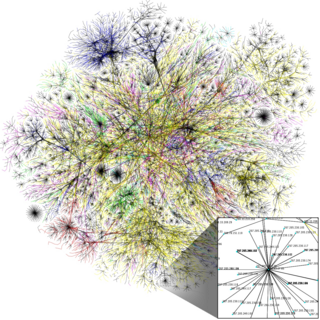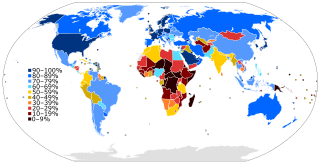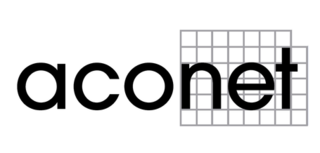
Integrated Services Digital Network (ISDN) is a set of communication standards for simultaneous digital transmission of voice, video, data, and other network services over the digitalised circuits of the public switched telephone network. Work on the standard began in 1980 at Bell Labs and was formally standardized in 1988 in the CCITT "Red Book". By the time the standard was released, newer networking systems with much greater speeds were available, and ISDN saw relatively little uptake in the wider market. One estimate suggests ISDN use peaked at a worldwide total of 25 million subscribers at a time when 1.3 billion analog lines were in use. ISDN has largely been replaced with digital subscriber line (DSL) systems of much higher performance.

Janet is a high-speed network for the UK research and education community provided by Jisc, a not-for-profit company set up to provide computing support for education. It serves 18 million users and is the busiest National Research and Education Network in Europe by volume of data carried. Previously, Janet was a private, UK-government funded organisation, which provided the JANET computer network and related collaborative services to UK research and education.
Telecommunications in Tuvalu cover Tuvalu's 6 atolls and 3 reef islands. The islands of Tuvalu rely on satellite dishes for communication and internet access.
The telecommunication systems in Vanuatu provides voice and data services to the island nation.
In telecommunications and computing, bit rate is the number of bits that are conveyed or processed per unit of time.

Internet access is the ability of individuals and organizations to connect to the Internet using computer terminals, computers, and other devices; and to access services such as email and the World Wide Web. Internet access is sold by Internet service providers (ISPs) delivering connectivity at a wide range of data transfer rates via various networking technologies. Many organizations, including a growing number of municipal entities, also provide cost-free wireless access and landlines.
A leased line is a private telecommunications circuit between two or more locations provided according to a commercial contract. It is sometimes also known as a private circuit, and as a data line in the UK. Typically, leased lines are used by businesses to connect geographically distant offices.
NORDUnet is an international collaboration between the National research and education networks in the Nordic countries.
In telecommunications, cable Internet access, shortened to cable Internet, is a form of broadband Internet access which uses the same infrastructure as a cable television. Like digital subscriber line and fiber to the premises services, cable Internet access provides network edge connectivity from the Internet service provider to an end user. It is integrated into the cable television infrastructure analogously to DSL which uses the existing telephone network. Cable TV networks and telecommunications networks are the two predominant forms of residential Internet access. Recently, both have seen increased competition from fiber deployments, wireless, and mobile networks.

SURF is an organization that develops, implements and maintains the national research and education network (NREN) of the Netherlands, It operates the national research network formally called SURFnet.

Internet in Russia or Russian Internet and sometimes Runet is a part of the Internet which is related to Russia. As of 2015 Internet access in Russia is available to businesses and to home users in various forms, including dial-up, cable, DSL, FTTH, mobile, wireless and satellite.

The Internet in Africa is limited by a lower penetration rate when compared to the rest of the world. Measurable parameters such as the number of ISP subscriptions, overall number of hosts, IXP-traffic, and overall available bandwidth are indicators that Africa is far behind the "digital divide". Moreover, Africa itself exhibits an inner digital divide, with most Internet activity and infrastructure concentrated in South Africa, Morocco, Egypt as well as smaller economies like Mauritius and Seychelles. In general, only 24.4% of the African population have access to the Internet, as of 2018. Only 0.4% of the African population has a fixed-broadband subscription. The majority of internet users use it through mobile broadband.
Delivery of Advanced Network Technology to Europe (DANTE) is a not-for-profit company that plans, builds and operates the consecutive generations of the backbone network that interconnects the national research and education networks (NRENs) in Europe. The organisation is based in Cambridge, United Kingdom and was formed in 1993 as a limited liability company owned by Réseaux Associés pour la Recherche Européenne (RARE). Ownership was transferred to a number of NRENs and government agencies in 1994.
Internet in Australia first became available on a permanent basis to universities in Australia in May 1989, via AARNet. Pegasus Networks was Australia's first public Internet provider in June 1989. The first commercial dial-up Internet Service Provider (ISP) appeared in capital cities soon after, and by the mid-1990s almost the entire country had a range of choices of dial-up ISPs. Today, Internet access is available through a range of technologies, i.e. hybrid fibre coaxial cable, digital subscriber line (DSL), Integrated Services Digital Network (ISDN) and satellite Internet. In July 2009, the federal government, in partnership with the industrial sector, began rolling out a nationwide fibre-to-the-premises (FTTP) and improved fixed wireless and satellite access through the National Broadband Network. Subsequently, the roll out was downgraded to a Multi-Technology Mix on the promise of it being less expensive and with earlier completion. In October 2020, the federal government announced an upgrade by 2023 of NBN fibre-to-the-node (FTTN) services to FTTP for 2 million households, at a cost of A$3.5 billion.

The United Kingdom has been involved with the Internet throughout its origins and development. The telecommunications infrastructure in the United Kingdom provides Internet access to businesses and home users in various forms, including fibre, cable, DSL, wireless and mobile.

The Education and Research Network (ERNET) is an autonomous scientific society of the Ministry of Electronics and Information Technology, Government of India. ERNET has made a significant contribution to the emergence of networking in the country. It practically brought the Internet to India and has built up national capabilities in the area of net-working, especially in protocol software engineering. It is the first internet service in india. It has not only succeeded in building a large network that provides various facilities to the intellectual segment of Indian society—the research and education community, it has over the years become a trendsetter in the field of networking.
Saint Helena, Ascension and Tristan da Cunha is a British Overseas Territory in the South Atlantic, consisting of the island of Saint Helena, Ascension Island and the archipelago of Tristan da Cunha including Gough Island. Their communications provision includes dedicated radio and television stations, and telecommunications infrastructure.

ACOnet is the name of the national research and education network in Austria. The ACONET association promotes the development and use of that network. ACOnet is not managed and operated by ACONET, but by a unit in the Computing Centre of the University of Vienna that also operates the Vienna Internet Exchange. The University of Vienna represents ACOnet internationally, for example as a member of TERENA and as a participant in the project that funds the European backbone network GÉANT.

Airborne Internet is a concept that overlays network theory and principles into the transportation realm. The system goal is to establish information connectivity. To reach that goal, the system must create a scalable, general purpose, multi-application data channel for people in transit.








